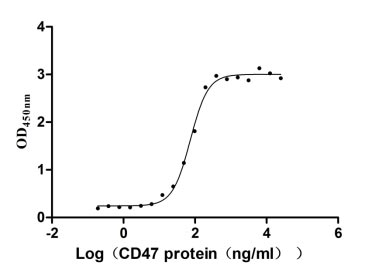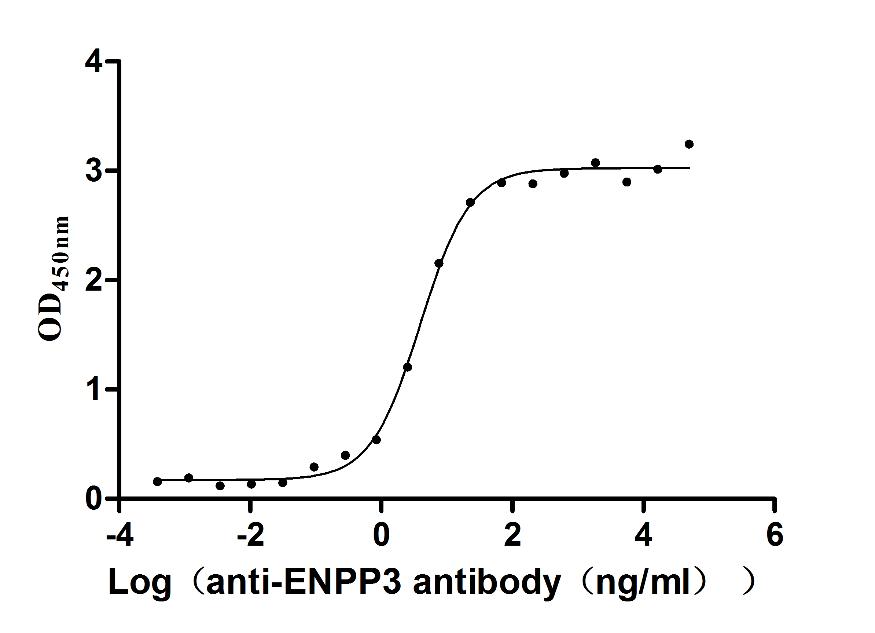Recombinant Mouse G1/S-specific cyclin-D3 (Ccnd3)
-
货号:CSB-YP004814MO
-
规格:
-
来源:Yeast
-
其他:
-
货号:CSB-EP004814MO
-
规格:
-
来源:E.coli
-
其他:
-
货号:CSB-EP004814MO-B
-
规格:
-
来源:E.coli
-
共轭:Avi-tag Biotinylated
E. coli biotin ligase (BirA) is highly specific in covalently attaching biotin to the 15 amino acid AviTag peptide. This recombinant protein was biotinylated in vivo by AviTag-BirA technology, which method is BriA catalyzes amide linkage between the biotin and the specific lysine of the AviTag.
-
其他:
-
货号:CSB-BP004814MO
-
规格:
-
来源:Baculovirus
-
其他:
-
货号:CSB-MP004814MO
-
规格:
-
来源:Mammalian cell
-
其他:
产品详情
-
纯度:>85% (SDS-PAGE)
-
基因名:
-
Uniprot No.:
-
别名:Ccnd3; Cyl-3; G1/S-specific cyclin-D3
-
种属:Mus musculus (Mouse)
-
蛋白长度:Full length protein
-
表达区域:1-292
-
氨基酸序列MELLCCEGTR HAPRAGPDPR LLGDQRVLQS LLRLEERYVP RASYFQCVQK EIKPHMRKML AYWMLEVCEE QRCEEDVFPL AMNYLDRYLS CVPTRKAQLQ LLGTVCLLLA SKLRETTPLT IEKLCIYTDQ AVAPWQLREW EVLVLGKLKW DLAAVIAHDF LALILHRLSL PSDRQALVKK HAQTFLALCA TDYTFAMYPP SMIATGSIGA AVLGLGACSM SADELTELLA GITGTEVDCL RACQEQIEAA LRESLREAAQ TAPSPVPKAP RGSSSQGPSQ TSTPTDVTAI HL
-
蛋白标签:Tag type will be determined during the manufacturing process.
The tag type will be determined during production process. If you have specified tag type, please tell us and we will develop the specified tag preferentially. -
产品提供形式:Lyophilized powder
Note: We will preferentially ship the format that we have in stock, however, if you have any special requirement for the format, please remark your requirement when placing the order, we will prepare according to your demand. -
复溶:We recommend that this vial be briefly centrifuged prior to opening to bring the contents to the bottom. Please reconstitute protein in deionized sterile water to a concentration of 0.1-1.0 mg/mL.We recommend to add 5-50% of glycerol (final concentration) and aliquot for long-term storage at -20℃/-80℃. Our default final concentration of glycerol is 50%. Customers could use it as reference.
-
储存条件:Store at -20°C/-80°C upon receipt, aliquoting is necessary for mutiple use. Avoid repeated freeze-thaw cycles.
-
保质期:The shelf life is related to many factors, storage state, buffer ingredients, storage temperature and the stability of the protein itself.
Generally, the shelf life of liquid form is 6 months at -20°C/-80°C. The shelf life of lyophilized form is 12 months at -20°C/-80°C. -
货期:Delivery time may differ from different purchasing way or location, please kindly consult your local distributors for specific delivery time.Note: All of our proteins are default shipped with normal blue ice packs, if you request to ship with dry ice, please communicate with us in advance and extra fees will be charged.
-
注意事项:Repeated freezing and thawing is not recommended. Store working aliquots at 4°C for up to one week.
-
Datasheet :Please contact us to get it.
靶点详情
-
功能:Regulatory component of the cyclin D3-CDK4 (DC) complex that phosphorylates and inhibits members of the retinoblastoma (RB) protein family including RB1 and regulates the cell-cycle during G(1)/S transition. Phosphorylation of RB1 allows dissociation of the transcription factor E2F from the RB/E2F complex and the subsequent transcription of E2F target genes which are responsible for the progression through the G(1) phase. Hypophosphorylates RB1 in early G(1) phase. Cyclin D-CDK4 complexes are major integrators of various mitogenenic and antimitogenic signals. Component of the ternary complex, cyclin D3/CDK4/CDKN1B, required for nuclear translocation and activity of the cyclin D-CDK4 complex. Shows transcriptional coactivator activity with ATF5 independently of CDK4.
-
基因功能参考文献:
- These results suggest that progesterone receptor overexpression in endometrial stromal cells, likely due to high progesterone levels, triggers cyclin D3 and Hoxa-10 overexpression, which may be involved in the pathological mechanisms of the mouse uterine decidual reaction. PMID: 27511308
- the activation of TLR7 increased CCND3 expression via the downregulation of miR-15b in B cells. PMID: 26144250
- immature B and T cells use lymphocyte lineage- and developmental stage-specific mechanisms to inhibit Cyclin D3 protein levels. PMID: 27327568
- we suggest that proper regional decidualization and polyploidy development requires FoxM1 signaling downstream of Hoxa10 and cyclin D3. PMID: 26350477
- DYRK1A has a role in lymphopoiesis; Cyclin D3 protein stability is negatively regulated during exit from the proliferative phases of B and T cell development PMID: 26008897
- inactivation of Ccnd3 leads to increased frequencies of lymphocytes with biallelic expression of IgH or TCRbeta genes. PMID: 25127855
- Results indicate that cyclin D3 plays a cell-autonomous and nonredundant function in regulating the dynamic balance between proliferation, differentiation, and self-renewal that normally establishes an appropriate pool size of adult satellite cells. PMID: 23897741
- Investigated the expression of GABA and GABPR in the early-pregnancy mouse uterus. Cyclin D3 was measured in cultured stromal cells artificially induced to undergo decidualization, by GABA and a GABA A-type receptor agonist or antagonist. PMID: 23150429
- Subnuclear compartmentalization enables cyclin D3 to drive cell cycle progression and repress V gene accessibility, thereby ensuring coordination of proliferation with immunoglobulin recombination. PMID: 23109711
- cyclin D3 expression influences a host of genes involved in decidualization and can improve decidualization in Hoxa-10(-/-) mice. PMID: 23008516
- CCND3 gene product cyclin D3 regulates the number of cell divisions that erythroid precursors undergo during terminal differentiation PMID: 22929040
- Cyclin D3 primes myoblasts for differentiation by enhancing muscle specific gene expression and cell cycle exit. PMID: 21898542
- Ccnd3(-/-) mice exhibit a B-cell-intrinsic defect in germinal center maturation and fail to generate an affinity-matured IgG response. The defect resulted from failed proliferative expansion of GL7(+) IgD(-) PNA(+) B cells. PMID: 20956554
- coordinate expression and functional association of cyclin D3 with cdk4 suggest a role for proliferation and, that of cyclin D3 with p21 and cdk6 is consistent with the development of polyploidy during stromal cell decidualization PMID: 11804782
- cyclin D3 expression is regulated through different pathways and plays a distinct role in the liver PMID: 12085346
- cyclin D3-cdk4 activity represses skeletal muscle differentiation by blocking the association of MEF2 with the coactivator GRIP-1 and concomitantly disrupts the associateion of these factors with punctate nuclear subdomains within the cell PMID: 12130539
- Overexpression of both Cdk6 & D3 enhances susceptibility of BALB/c3T3 & C3H10T1/2 mouse fibroblast lines to UV radiation & 3-methylcholanthrene transformation. Deregulated expression of Cdk6 & cyclin D3 may predispose cells to malignant transformation. PMID: 12592386
- knock-down of cyclin D3 inhibited proliferation of acute lymphoblastic leukemias deriving from immature T lymphocytes PMID: 14706337
- Cdk6-cyclin D3 complexes are not subject to inhibition by p16(INK4a) PMID: 14724578
- cyclin d3 does not have a role in regulating AML1/RUNX1 increase during G1 to S cell cycle progression PMID: 14747476
- cyclin D3 is an important factor governing adipogenesis and obesity through activation of peroxisome proliferator-activated receptor gamma PMID: 16260612
- Cyclin D3 is increased during differentiation and phosphorylates C/EBPalpha at Ser193, leading to the formation of growth-inhibitory C/EBPalpha-cdk2 and C/EBPalpha-Brm complexes. PMID: 16537903
- Cyclin D3 plays a key role in normal B-1a lymphocyte mitogenesis. PMID: 16818732
- Results demonstrate that cyclin D3 is an essential cell cycle recipient of G-CSF signaling, and provide a molecular link of how G-CSF-dependent signaling triggers cell proliferation. PMID: 16954383
- identification of cyclin D3 as a novel binding partner of lamin A/C has important implications for a role for lamin A/C in muscle differentiation PMID: 17321498
- These results indicate that the pRb-dependent accumulation of cyclin D3 is functionally relevant to the process of skeletal muscle cell differentiation. PMID: 17709384
- These results provide, at least in part, an explanation for the defective small decidua of mice lacking the Il11ra gene, and reveal for the first time that cyclin D3, CDKN1A (p21), and BIRC5 (Survivin) are targets of IL11 in the decidua. PMID: 17881769
- A new HDAC5 target is identified: the gene encoding the cell cycle-regulatory protein cyclin D3. PMID: 18404677
- Inhibition of PLCbeta1 activity prevents the upregulation of cyclinD3 and cdk4 protein, suggesting that PLCbeta1 plays a role in the control of the cell cycle during differentiation. PMID: 19385066
- pre-BCR-mediated activation of the Ras-MEK-Erk signaling pathway silenced transcription of Ccnd3 and coordinated exit from the cell cycle with induction of the transcription factor E2A PMID: 19734904
- Alpha interferon suppresses the cyclin D3 and cdc25A genes, leading to a reversible G0-like arrest. PMID: 8668211
显示更多
收起更多
-
亚细胞定位:Nucleus. Cytoplasm.
-
蛋白家族:Cyclin family, Cyclin D subfamily
-
数据库链接:
KEGG: mmu:12445
STRING: 10090.ENSMUSP00000040488
UniGene: Mm.27291
Most popular with customers
-
Recombinant Human Leukocyte surface antigen CD47 (CD47), partial (Active)
Express system: Mammalian cell
Species: Homo sapiens (Human)
-
Recombinant Macaca mulatta Semaphorin-4D isoform 1 (SEMA4D), partial (Active)
Express system: Mammalian cell
Species: Macaca mulatta (Rhesus macaque)
-
Express system: Mammalian cell
Species: Macaca fascicularis (Crab-eating macaque) (Cynomolgus monkey)
-
Recombinant Macaca fascicularis Membrane spanning 4-domains A1 (MS4A1)-VLPs (Active)
Express system: Mammalian cell
Species: Macaca fascicularis (Crab-eating macaque) (Cynomolgus monkey)
-
Recombinant Human C-C chemokine receptor type 8 (CCR8)-VLPs (Active)
Express system: Mammalian cell
Species: Homo sapiens (Human)
-
Recombinant Human Desmoglein-2 (DSG2), partial (Active)
Express system: Mammalian cell
Species: Homo sapiens (Human)
-
Recombinant Human Serotransferrin(TF) (Active)
Express system: Mammalian cell
Species: Homo sapiens (Human)
-
Express system: Mammalian cell
Species: Homo sapiens (Human)




















